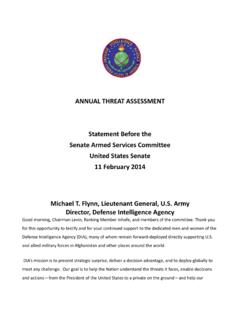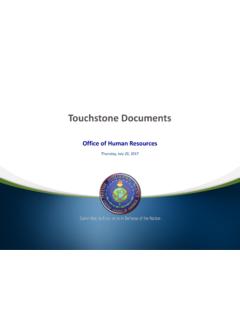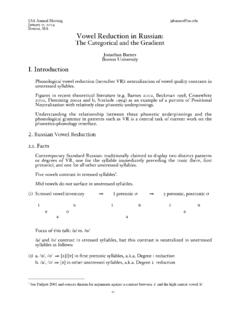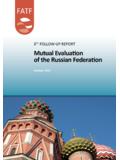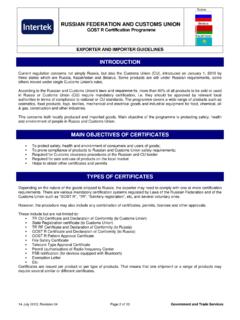Transcription of INTENTIONALLY LEFT BLANK - Defense Intelligence …
1 This report is available online at For media and public inquiries about this report, contact For more information about the Defense Intelligence Agency, visit DIA's website at image, russian tanks, model T90A. Source: Shutterstock. DIA-11-1704-161 INTENTIONALLY LEFT BLANKIVPREFACEFor more than 50 years, DIA officers have met the full range of security challenges facing our great nation. Our Intelligence professionals operate across the globe, and our work supports customers from the forward-deployed warfighter to the national policymaker. DIA is united in a common vision to be the indispensable source of Defense Intelligence expertise and for the past five decades we have done just part of this vision, DIA has a long history of producing comprehensive and authoritative Defense Intelligence overviews. In September 1981, Secretary of Defense Caspar Weinberger asked the Defense Intelligence Agency to produce an unclassified overview of the Soviet Union s military strength.
2 The purpose was to provide America's leaders, the national security community, and the public a complete and accurate view of the threat. The result: the first edition of Soviet Military Power. DIA produced over 250,000 copies, and it soon became an annual publication that was translated into eight languages and distributed around the world. In many cases, this report conveyed the scope and breadth of Soviet military strength to policymakers and the public for the first , we are faced with a complexity of Intelligence challenges from multiple threats that we cannot afford to misunderstand. In the spirit of Soviet Military Power, DIA is proud to produce an unclassified Defense Intelligence overview of the military capabilities associated with the challenges we face beginning with Russia. This product is intended to foster a dialogue between leaders, the national security community, partner nations, and the public about the challenges we face in the 21st MILITARY POWERB uilding a Military to Support Great Power AspirationsDEFENSE Intelligence AGENCYVThe international order established after the Second World War and developed throughout the Cold War largely ensured widespread peace and stability even as it saw new conflicts large and small take place in different regions of the world.
3 This post-war era, underwritten primarily by the strength of the United States, also gave rise to the greatest period of prosperity in history, witnessing countries rebuild from war and emerge from colonialism to become vibrant and valuable members of the international community. Following the collapse of the Soviet Union, the United States emerged as a world leader militarily, economically and diplomatically. Today, however, the United States faces an increasingly complex array of challenges to our national resurgence of Russia on the world stage seizing the Crimean Peninsula, destabilizing eastern Ukraine, intervening on behalf of Syrian President Bashar al-Assad, and shaping the information environment to suit its interests poses a major challenge to the United States. Moscow will continue to aggressively pursue its foreign policy and security objectives by employing the full spectrum of the state s capabilities.
4 Its powerful military, coupled with the actual or perceived threat of intervention, allows its whole-of-government efforts to resonate continues to modernize its extensive nuclear forces and is developing long range precision-guided conventional weapons systems. It is manipulating the global information environment, employing tools of indirect action against countries on its periphery and using its military for power projection and expeditionary force deployments far outside its borders. Its ultimate deterrent is a robust nuclear force capable of conducting a massed nuclear strike on targets in the United States within the next decade, an even more confident and capable Russia could emerge. The United States needs to anticipate, rather than react, to russian actions and pursue a greater awareness of russian goals and capabilities to prevent potential conflicts. Our policymakers and commanders must have a complete understanding of Russia s military capabilities, especially as and russian forces may increasingly encounter each other around the globe.
5 DIA will continue to provide our leaders decision-space, ensuring they have the time and information necessary to protect our nation. The wrong decisions or the right ones made too late could have dire report examines a resurgent Russia s military power to foster a deeper understanding of its core capabilities, goals, and aspirations in the 21st R. StewartLieutenant General, USMC Director Defense Intelligence AgencyVladimir Putin s address to the russian Federal Assembly following the referendum on annexation of Crimea, 18 March, 2014: The USA prefers to follow the rule of the strongest and not by the international law. They are convinced that they have been chosen and they are exceptional, that they are allowed to shape the destiny of the world, that it is only them that can be right. They act as they please. Here and there they use force against sovereign states, set up coalitions in accordance with the principle: who is not with us is against us.
6 INTENTIONALLY LEFT BLANKRUSSIA MILITARY POWERB uilding a Military to Support Great Power AspirationsDEFENSE Intelligence AGENCYVIII ntroduction/Historical Overview ..91991 Present: Fall and Rise of the russian Military .. 9 russian National Military Overview ..14 Russia s Threat Perceptions .. 14 National Security Strategy ..16 Stability Issues .. 17 External Defense Relations ..19 Defense Budget .. 19 Military Doctrine and Strategy .. 22 russian Perceptions of Modern Conflict .. 22 Military and Security Leadership .. 23 Main Operations Directorate 25 National Military Command and Control .. 25 russian Nuclear Command and Control 26 Command and Control of Joint Forces 27 Core russian Military Capabilities.
7 29 Nuclear Forces and Weapons .. 29 Biological and Chemical Weapons .. 31 Anti-Access/Area Denial .. 32 Information Operations 32 Strategic Air Operations 32 Integrated Air Defense System 33 Modern Precision Strike Capabilities 33 CONTENTSVIIIP recision Strike .. 34 Space/Counterspace .. 35 Cyber .. 37 Propaganda Helps Shape The Information Environment 38 Cyber-Enabled Psychological Operations 39 Information Defense 40 Media Laws A Hedge Against Instability 41 Indirect Action.
8 41 Electronic Warfare .. 42 Power Projection .. 42 Underground Facilities .. 44 Denial and Deception .. 45 Outlook: A Modernizing Force .. 46 Appendix A: russian Strategic Rocket Forces .. 47 Appendix B: russian Ground Forces .. 50 Appendix C: russian Aerospace Forces .. 58 Appendix D: russian Navy .. 66 Appendix E: russian Special Operations Forces .. 71 Appendix F: russian Intelligence Services .. 72 Appendix G: Defense Industry and Modernization Programs .. 75 Appendix H: Arms Sales .. 85 RUSSIA MILITARY POWERB uilding a Military to Support Great Power AspirationsDEFENSE Intelligence AGENCY9 Introduction/Historical Overview1991-Present: Fall and Rise of the russian Militaryollowing the collapse of the USSR in 1991, the russian Federation inher-ited several formidable tasks and chal-lenges from its Soviet predecessor. For the new-ly-formed russian Ministry of Defense , the most immediate challenge was to relocate military equipment and personnel from the newly inde-pendent states of the former USSR and coun-tries of the disbanded Warsaw Pact into a new russian The assets of the Soviet Union s nuclear arsenal were of particular importance.
9 Russia, Ukraine, Belarus, and Kazakhstan, the four states with nuclear weapons in their territory, eventually reached an agreement to dismantle all tactical and strategic nuclear weapons in the non- russian republics or return them to The issue of conventional mili-tary forces was much more problematic. Forces returning from Eastern Europe had to be rein-tegrated into the new russian military, while FKremlin Guards in 2017. Military power has always been regarded as of critical importance by russian and Soviet leaders, but after the collapse of the USSR, Moscow was left with a dramatically weakened Source: Shutterstock10those in the newly independent states were viewed as the basis for building national mili-taries for new sovereign military forces from Eastern Europe were often shipped piecemeal back to unprepared bases in the russian Other units located in the territory of the former Soviet Union were absorbed by the newly independent states.
10 In certain cases, units such as the Black Sea Fleet in Ukraine or the 14th Army in Moldova actively resisted the attempts by the Soviet successor states to absorb these forces. Some of these stranded units became embroiled in ethnic conflicts in Moldova, Georgia, and Most sig-nificantly for the new russian military, inte-rior military districts, which under the Soviet Union contained low-readiness mobilization forces such as the Moscow and North Cauca-sus Military Districts, now became front-line districts bordering foreign The Rus-sian Federation emerged from the collapse of the Soviet Union with a much smaller military and an entirely new set of security s new military faced dramatic budget-ary, readiness, and personnel shortfalls, as well as uncertainty of its role as Moscow strug-gled to determine its place in the post-Cold War , 9 Russia cut military spending drasti-cally during the decade of post-Soviet economic turbulence.
